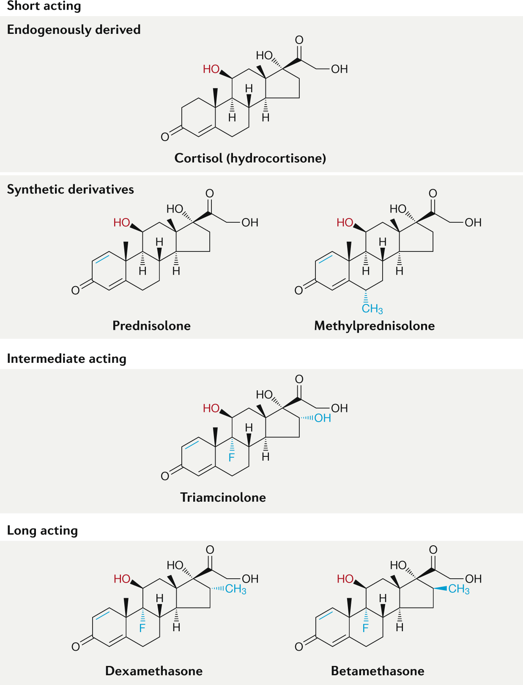当前位置:
X-MOL 学术
›
Nat. Rev. Rheumatol.
›
论文详情
Our official English website, www.x-mol.net, welcomes your
feedback! (Note: you will need to create a separate account there.)
Therapeutic glucocorticoids: mechanisms of actions in rheumatic diseases.
Nature Reviews Rheumatology ( IF 29.4 ) Pub Date : 2020-02-07 , DOI: 10.1038/s41584-020-0371-y Rowan S Hardy 1 , Karim Raza 2 , Mark S Cooper 3
Nature Reviews Rheumatology ( IF 29.4 ) Pub Date : 2020-02-07 , DOI: 10.1038/s41584-020-0371-y Rowan S Hardy 1 , Karim Raza 2 , Mark S Cooper 3
Affiliation

|
Therapeutic glucocorticoids have been widely used in rheumatic diseases since they became available over 60 years ago. Despite the advent of more specific biologic therapies, a notable proportion of individuals with chronic rheumatic diseases continue to be treated with these drugs. Glucocorticoids are powerful, broad-spectrum anti-inflammatory agents, but their use is complicated by an equally broad range of adverse effects. The specific cellular mechanisms by which glucocorticoids have their therapeutic action have been difficult to identify, and attempts to develop more selective drugs on the basis of the action of glucocorticoids have proven difficult. The actions of glucocorticoids seem to be highly cell-type and context dependent. Despite emerging data on the effect of tissue-specific manipulation of glucocorticoid receptors in mouse models of inflammation, the cell types and intracellular targets of glucocorticoids in rheumatic diseases have not been fully identified. Although showing some signs of decline, the use of systemic glucocorticoids in rheumatology is likely to continue to be widespread, and careful consideration is required by rheumatologists to balance the beneficial effects and deleterious effects of these agents.
中文翻译:

治疗性糖皮质激素:风湿性疾病的作用机理。
自60年前问世以来,糖皮质激素治疗药物已广泛用于风湿性疾病。尽管出现了更具体的生物疗法,但是仍有相当一部分患有慢性风湿病的个体继续使用这些药物进行治疗。糖皮质激素是功能强大的广谱抗炎药,但由于副作用范围广泛,使它们的使用变得复杂。糖皮质激素具有其治疗作用的特定细胞机制已经难以确定,并且已经证明尝试根据糖皮质激素的作用开发更具选择性的药物是困难的。糖皮质激素的作用似乎是高度细胞类型和上下文相关的。尽管有关于糖皮质激素受体的组织特异性操纵在炎症小鼠模型中作用的新兴数据,但尚未完全确定风湿性疾病中糖皮质激素的细胞类型和细胞内靶标。尽管显示出一些下降的迹象,但全身性糖皮质激素在风湿病学中的应用可能会继续广泛使用,风湿病学家需要仔细考虑以平衡这些药物的有益作用和有害作用。
更新日期:2020-02-07
中文翻译:

治疗性糖皮质激素:风湿性疾病的作用机理。
自60年前问世以来,糖皮质激素治疗药物已广泛用于风湿性疾病。尽管出现了更具体的生物疗法,但是仍有相当一部分患有慢性风湿病的个体继续使用这些药物进行治疗。糖皮质激素是功能强大的广谱抗炎药,但由于副作用范围广泛,使它们的使用变得复杂。糖皮质激素具有其治疗作用的特定细胞机制已经难以确定,并且已经证明尝试根据糖皮质激素的作用开发更具选择性的药物是困难的。糖皮质激素的作用似乎是高度细胞类型和上下文相关的。尽管有关于糖皮质激素受体的组织特异性操纵在炎症小鼠模型中作用的新兴数据,但尚未完全确定风湿性疾病中糖皮质激素的细胞类型和细胞内靶标。尽管显示出一些下降的迹象,但全身性糖皮质激素在风湿病学中的应用可能会继续广泛使用,风湿病学家需要仔细考虑以平衡这些药物的有益作用和有害作用。











































 京公网安备 11010802027423号
京公网安备 11010802027423号